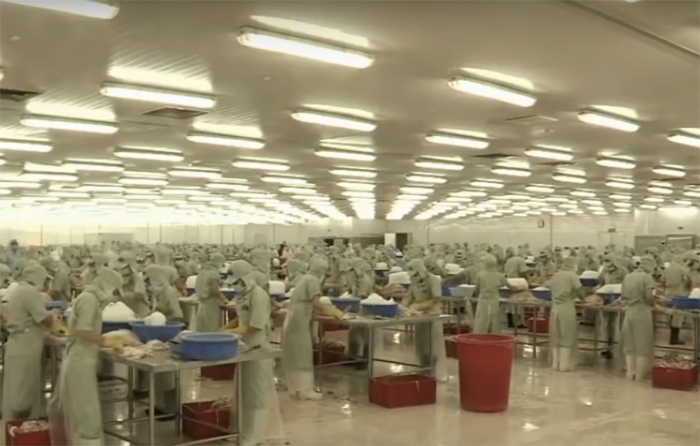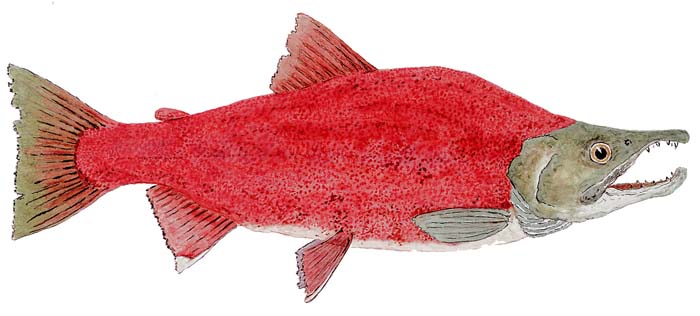
In Viet Nam in one fish processing plant, over a 1,000 employees process, Basa (Pangasius bocourti). It’s a species of catfish in the family Pangasiidae. Basa is native to Asia, but the Vietnamese exporters of this fish now label their products sold in the U.S. as basa.
Nutritional content of farmed fish is very different from wild salmon
The following is excerpted from the original article by Dr. Mercola, titled “Why Farmed Salmon Are a Toxic ‘Junk Food.’”
[dropcap]T[/dropcap]he flesh of the farmed salmon is oddly brittle and breaks apart when bent — a highly abnormal feature. The nutritional content is also wildly abnormal. Wild salmon contain about 5 to 7 percent fat, whereas the farmed variety can contain anywhere from 14.5 to 34 percent. For a visual demonstration of this difference in fat content, check out the video.
The elevated fat content is a direct result of the processed high-fat feed that farmed salmon are given. But farmed salmon don’t just contain more fat overall:
The real tragedy is the radically skewed ratios of omega-3 to omega-6 fats.6 Half a fillet of wild Atlantic salmon contains about 3,996 milligrams (mg) of omega-3 and 341 mg of omega-6.7 Half a fillet of farmed salmon from the Atlantic contains just a bit more omega-3 — 4,961 mg — but an astounding 1,944 mg of omega-6;8 more than 5.5 times more than wild salmon.
While you need both omega-3 and omega-6 fats, the ratio between the two is important and should ideally be about 1-to-1. The standard American diet is already heavily skewed toward omega-6, thanks to the prevalence of processed foods, and with farmed salmon, that unhealthy imbalance is further magnified rather than corrected.
Farmed and Dangerous9 provides an example of a salmon feed label, and the ingredients are very telling in terms of where these excess omega-6 fats are coming from. The first nine ingredients in Skretting’s “Winter Plus 3500″ salmon feed are poultry meal, fish meal, poultry fat, fish oil, whole wheat, soybean meal, corn gluten meal, feather meal and rapeseed oil. These are all ingredients that no wild salmon has ever encountered and is about as far from a species-appropriate diet as you can get.”
If the current administration gets what they want, approval of the Pebble Mine project, Americans stand to forfeit the healthiest salmon resource in the world
Authentic wild-caught Alaskan sockeye salmon is the best there is; the nutritional benefits of which I believe still outweigh any potential contamination. The risk of sockeye accumulating high amounts of mercury and other toxins is reduced because of its short life cycle, which is only about three years. Additionally, bioaccumulation of toxins is also reduced by the fact that it doesn’t feed on other, already contaminated, fish.
Alaskan salmon (not to be confused with Atlantic salmon) is not allowed to be farmed, and is therefore always wild-caught. My favorite brand is Vital Choice Wild Seafood and Organics, which offers a nice variety of high-quality salmon products that test high for omega-3 fats and low for contaminants.
Canned salmon labeled “Alaskan salmon” is a less expensive alternative to salmon fillets. Remember that wild salmon is quite lean, so the fat marks — those white stripes you see in the meat — are on the thin side. If a fish is pale pink with wide fat marks, the salmon is likely farmed. Avoid Atlantic salmon, as salmon bearing this label are almost always farmed.

An Alaskan adult male sockeye salmon (Oncorhynchus nerka) in spawning colors. Illustration courtesy of Thom Glace.
Another exception is smaller fish with short life cycles, which also tend to be better alternatives in terms of fat content, such as sardines and anchovies. With their low contamination risk and higher nutritional value, they are a win-win alternative. As a general rule, the closer to the bottom of the food chain the fish is, the less contamination it will accumulate.
To read the full story click here . . .






Join the discussion One Comment